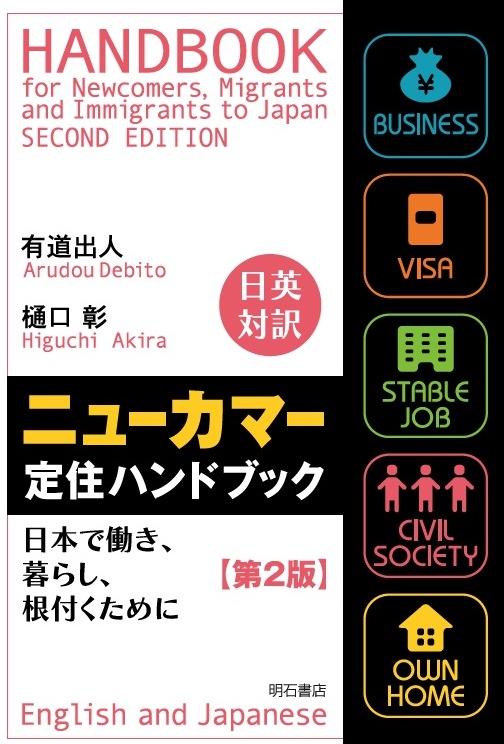mytest
Books, eBooks, and more from Dr. Debito Arudou (click on icon):





![]()


UPDATES ON TWITTER: arudoudebito
DEBITO.ORG PODCASTS on iTunes, subscribe free
“LIKE” US on Facebook at http://www.facebook.com/debitoorg
https://www.facebook.com/embeddedrcsmJapan
http://www.facebook.com/handbookimmigrants
https://www.facebook.com/JapaneseOnlyTheBook
https://www.facebook.com/BookInAppropriate
Hi Blog. Here’s my latest for the Shingetsu News Agency. Enjoy. Debito Arudou, Ph.D.
Visible Minorities Column 2: Educating the Non-Japanese Underclass
Shingetsu News Agency, SEP 17, 2019 by DEBITO ARUDOU
http://shingetsunewsagency.com/2019/09/17/visible-minorities-educating-the-non-japanese-underclass/
SNA (Tokyo) — In a shocking series of exposés at the beginning of this month, the Mainichi Shinbun reported that minority children of workers in Japanese schools were being segregated from their Japanese peers, put in classes for the mentally disabled, and systematically denied an education.
For years now, according to Ministry of Education surveys, schools have subjected their non-native foreign minority students to IQ tests. The results were striking: Non-Japanese children were found to have “developmental disorders” at more than double the rate of the general Japanese student population.
Striking, but not all that surprising—since these tests assessed IQ via culturally-grounded questions, on things like Japanese shogunates and tanabata festivals. They also considered a lack of Japanese language skills an “intellectual” disability.
Let that sink in. Try claiming that your Japanese students are dim because they aren’t proficient in English, and then watch how long you remain an educator.
But here’s where the bad science turns evil. The “special education” Non-Japanese students were receiving tended to put them permanently behind their peers. In one cited example, instead of learning multiplication in school, a 14-year-old was pressed into child labor, digging potatoes.
Why weren’t these students simply put into regular classes, with additional after-school language instruction until they come up to speed? Because that would be unfair, said the administration. The Mainichi Shinbun cited an unnamed vice-principal as saying, “When foreigners increase in number, the learning progress of Japanese students is delayed. As far as is possible, foreign students should go to classes to be taught one on one”; meaning this “educator” believes that non-native speakers hobble their Japanese classmates.
I’m not a developmental psychologist, but I strongly doubt that this is supported by science. It’s certainly not supported by my experience. Having classmates learning English as a second language during my primary schooling in North America certainly didn’t slow down my classes or my own learning (and the non-native classmates came up to speed eventually). I especially doubt they would slow things down in a Japanese classroom, where in secondary education most students just keep silent anyway.
But the most shocking thing about this news story is that is it isn’t news. This has been going on for decades, notably since Japan started importing Non-Japanese from South America and Asia as cheap factory labor in the early 1990s.
In fact, disadvantaging Non-Japanese children is official government policy. Consider the Basic Act on Education; it is designed to guarantee compulsory education to everyone. However, as rendered in Japanese, “everyone” means kokumin, or citizens. The law thus enables educators to exclude foreigners.
That’s how it’s worked out in practice too; a number of schools have reportedly refused enrollment to Non-Japanese children with excuses of “a lack of facilities” or “too much work for teachers” or the alleged barriers of language and culture.
That’s one reason why alternative ethnic schools exist in Japan. However, those schools are almost never certified by the Ministry of Education, meaning that they aren’t “real schools” teaching the official curriculum, and don’t, for example, qualify for government educational subsidies or student discounts on public amenities and transportation. Further, their diplomas are not considered legitimate by many Japanese high schools and colleges. So if you want an education that avails you of equal opportunities as an adult in Japan, you had better get into a Japanese school, where they may still find ways to deem you disabled and throw you in a class digging potatoes.
The cruel results of this system were clear more than a decade ago: In 2007, the Yomiuri Shinbun reported that 20,000 Non-Japanese children lacked language abilities to follow classroom instruction. That same year, the Asahi Shinbun reported that an estimated 20-40% of all Brazilian-Japanese children were not attending, or had never attended, school in Japan.
This was reported in mainstream media outlets, yet more than ten years later, the government clearly felt no urgency to remedy the situation. On the contrary, they’re standing by as schools classify minority kids as retarded.
This is just how minorities are often treated in Japan—as invisible, as people who aren’t really here permanently, so they don’t need access to the essential social services, including a proper education for their children. This isn’t just cruel, it’s a fundamental and deliberate abrogation of human rights, potentially disadvantaging these kids their entire lives. Essentially, Japan has willfully created a functionally-illiterate day-laboring ethnic minority underclass.
So take heed: If you have a minority child in Japanese education, bear in mind that the system is not looking out for you.
Courtesyt http://shingetsunewsagency.com/2019/09/17/visible-minorities-educating-the-non-japanese-underclass/
=====================
Like what you read on Debito.org? Support our activities by making a donation here. Or just click on an advertisement below.
1 comment on ““Educating the Non-Japanese Underclass”, my Shingetsu News Agency “Visible Minorities” Col 2, Sept 17, 2019 (FULL TEXT)”
That sounds familiar. One American woman who I worked with had 2 sons who went to J schools and one was given an IQ test. She told me the test was “name the fish’ LOL. To see if you could tell a salmon from a mackerel or a tuna, etc. What a joke.